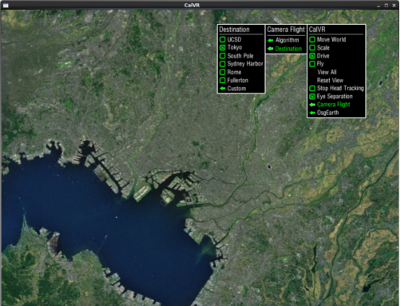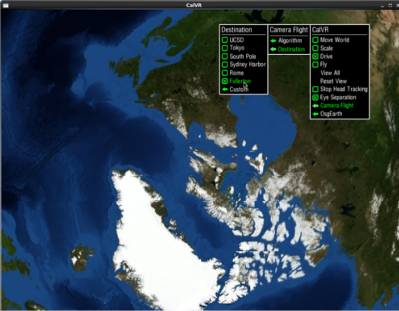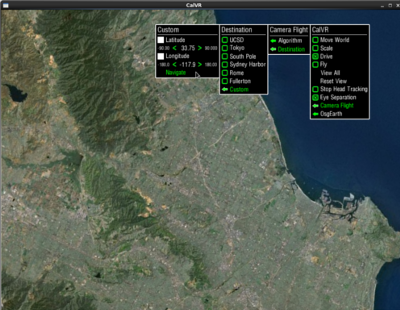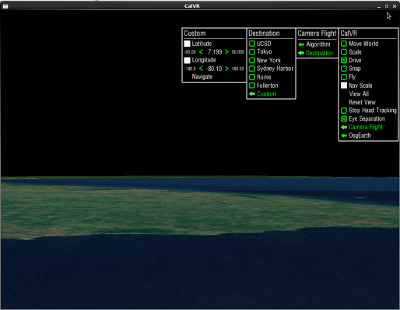CameraFlight
From Immersive Visualization Lab Wiki
Contents |
Project Overview
CameraFlight is a plugin for OsgEarth that helps users to navigate OsgEarth. Although the the project is named CameraFlight, the algorithm involves rotating earth and moving earth closer to Camera. There are two types of Navigation; Instant and Satellite. User can choose which algorithm to navigate osgEarth from algorithm sub-menu. Then user can choose one of the predefined destination or go to custom navigation menu and select latitude and longitude of the location and navigate. These navigations are time dependent.
Status
Implemented
- Created menu for plugin with algorithm submenu entries: instant, satellite, airplane.
- Created checkbox menu with list of predefined destinations. There are 6 predefined location; UCSD, Tokyo, South Pole, Sydney, Rome, Fullerton.
- Created custom destination submenu entries, which user can personally input latitude and longitude of destination and navigate. (works for both instant and satellite algorithm)
- Acquires the variables required to navigate; vectors of destination and current position, angle between the two vectors, and maximum and minimum height.
- Current and destination vectors are calculated by converting latitude and longitude of the location and making height to 0 and normalizing them.
- Using the cross product of the vectors will give us the rotation vector to rotate around.
- Angle between the vectors are calculated by acos((a*b)/(|a|*|b|)).
- Implemented instant navigation: switch to destination position immediately without transition
- Rotate from current vector to destination vector by angle between them once and set the height to the minimum.
- Implemented satellite mode: like Google Earth's transition mode, ~10 seconds for transition, time value is configurable in CalVR's configuration file
- This algorithm is time dependent and time is calculated every frame (maximum 10 seconds).
- Both zooming and rotation shares same base function of pow(t-5,2).
- For zooming, find a ratio using maxHeight and current height and apply the equation shown below:
For first 5 seconds:
a = (maxHeight - currentHeight)/25.0;
currentHeight = (-a * pow((t-5),2)) + maxHeight;
For Last 5 seconds:
a = (maxHeight - minHeight)/25.0;
currentHeight = (-a * pow((t-5),2)) + maxHeight;
- For Rotation, find angle rotating per each time interval using equation shown below:
rotationAngle = (original Angle + (-(original Angle / 25) * pow((t-5),2)))/360;
- Implemented custom destination menu using MenuRangeValue.
- User can set desired latitude and longitude of the planet and click navigate button to desired location.
- Converts inputted latitude and longitude into vectors and navigate with them.
- Implement airplane mode: the user will experience similar effect of being inside of the aircraft.
- Selecting Airplane mode will change the position of Camera so that the view will be in first person.
- This was done by having object matrix, all the way to Camera matrix and rotate the object along with Camera axis horizontally, and modified transition of earth back.
- If you select Instant or Satellite mode, Camera will return normally, facing earth down.
- Direction of the airplane will rotate towards the destination before flight.
- Selecting Airplane mode will change the position of Camera so that the view will be in first person.
xVector = crsV1^crsV2;
if(xVector.z() > 0);
if((origPlanetPoint.z()) > 0)
rotdir = right;
else
rotdir = left;
else
if((origPlanetPoint.z()) < 0)
rotdir = right;
else
rotdir = left;
- First find the angle between where you are facing and the destination, and then find cross product of two vectors, and then compare the z value of origPlanetPoint and the product. If the sign of both z.values are same, then rotate right, if not, rotate left.
- the plane will travel(rotate) in smilar manner with how the rotation is applied on satellite algorithm. The flight is also depending on time variable and slower than satellite, which around 30 seconds.
rotAngle = (origAngle + (-(origAngle/900)*pow((t-30),2)))/450;
- As plane travels, it will rise based on how much is the angle between from one point to another. For smooth transition, I have used cos(theta) to implement this.
For first 1/4 of angle:
v[2] = (maxHeight/2) * cos(PIE * (origAngle - angle)/(origAngle/4.0)) + (curHeight - (maxHeight/2));
For last 1/4 of angle:
v[2] = (maxHeight/2) * cos(PIE + (PIE * (1.0 - (angle/(origAngle/4.0))))) + (-6.373e+09(radius of earth) - (maxHeight/2));
- between 1/4 and 3/4 angle, the plane will fly without changing elevation.
- Since the elevation of plane will vary depending on where the plane is, plane will lower itself more if the elevation from ground is lower, and less if elevation is higher.
Milestones
- Implement GUI to save way points between starting points and destination. These points will help you create bezier curves of flight path.
- Define the transition time between each way points and maintain constant speed.
- Saving orientation of each way point is recommended.
Participants
Software Developers:
- William Seo
Project Advisors:
Development Assistance:
- Philip Weber
- Andrew Prudhomme
Initial Concept Base:
- Google Earth





